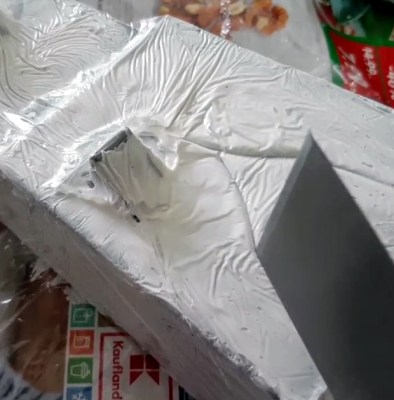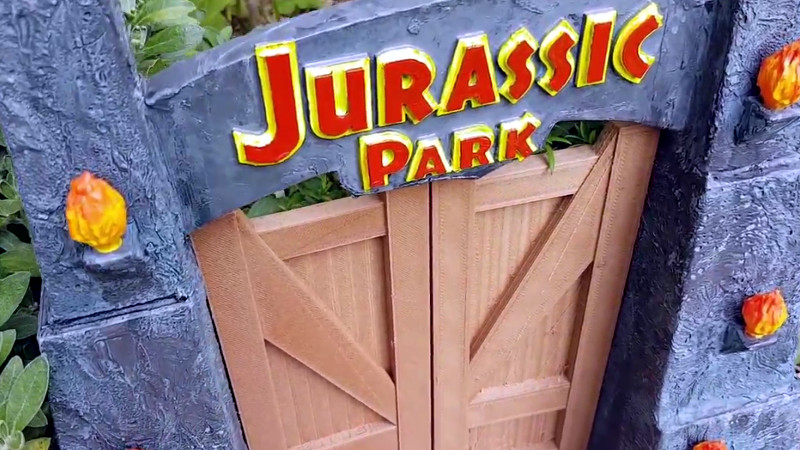Arguably one of the most difficult aspects of 3D printing is trying to make the finished product look like it wasn’t 3D printed. It can take a lot of time and work to cover up the telltale layer lines (or striations, if you want to get fancy), especially if your 3D printer isn’t perfectly calibrated. While there aren’t many shortcuts to achieve a glass-like finish on 3D printed parts, if your end goal is to make something that looks like stone, [Wekster] has a tip for you.
 He demonstrates the technique by building a gorgeous recreation of the main gate from Jurassic Park. The process gives the relatively smooth plastic the gnarled look of rough-hewn stone with very little in the way of manual work. While it’s true there’s no overabundance of projects this stone-look finish will work for, it’s definitely something we’ll be filing away mentally.
He demonstrates the technique by building a gorgeous recreation of the main gate from Jurassic Park. The process gives the relatively smooth plastic the gnarled look of rough-hewn stone with very little in the way of manual work. While it’s true there’s no overabundance of projects this stone-look finish will work for, it’s definitely something we’ll be filing away mentally.
So what’s the secret? [Wekster] first coats the 3D printed parts with common wood filler, the sort of stuff available at any hardware store. He then wraps them in clear plastic wrap, allowing the wrap to bunch up rather than trying to pull it taught. For extra detail, he digs into the plastic wrap here and there to create what will appear to be gaps and cracks on the finished piece. The wood filler is then left to dry; a process which normally only takes a few minutes, but now will take considerably longer as the plastic wrap will be keeping the air from it.
Once its hardened and unwrapped, [Wekster] sprays it with a base coat of color, and follows up with a few washings with watered down black and gray paints. This technique is well known to anyone who’s done miniature or model painting; serving to highlight the surface texture and give the finish more depth. With this method, anything that resembles a layer line in the print is long gone, and the surface looks so complex and detailed that at first glance few would believe it’s plastic.
[Wekster] also used wood filler during the finishing process for his Fallout 4 “Thirst Zapper” replica. In the past we’ve shown how you can smooth out 3D printed parts with epoxy and taken a very scientific look at using UV resin as a conformal coating, but maybe it’s time we give wood filler a shot.
















taut
:)
toit (like a tiger…)
impressive!
I’ve been looking at the PovRay source and the openSCAD source, trying to figure out how I can get “caustics”
anyone else interested in having a look?
You might try lightweight spackle or even Durham’s Water Putty, which can be rewet and reworked.
Really? I was expecting something completely different. I was expecting an efficient way to do this digitally before printing. I currntly have a process for adding real life textures but it makes the resulting print take about 20x as long to print. Finished print looks and feels awesome though.
same here, if you’ve used textures in something like povray, then go to openSCAD, the syntax is familiar, but the features are different.
lots of folks use povray to render, the stuff I’d like to do is and stone textures and “caustics”, then you could simulate corrosion and wear
Change the header to Jurassic Print then park an original threaded rod frame Mendel printer in front of the gate.
The diagonal supports in the doors are in the wrong way and thus loaded with pulling forces ;)
Thats because movie set designers aren’t engineers. And engineers don’t design movie sets
Just a heads-up for anyone looking to try this (or similar). What is sold as wood filler in hardware/home improvement stores, is usually the same as what’s sold as automotive body filler, without the wood coloured dye, for half the price. At least in the UK anyway.
you can make your own with polyester resin and talc
I add a powdered graphite which gives a good finish with fine free cut abrasive paper
Nice technique! I do not have a 3D printer, but I can see how this can prove to be useful for other modelling stuff too.